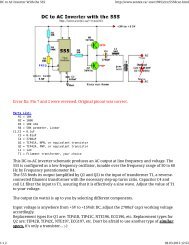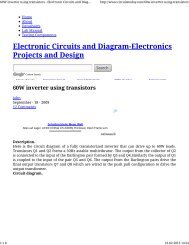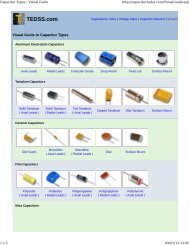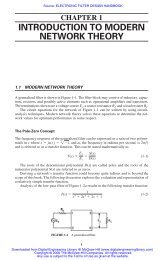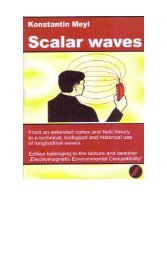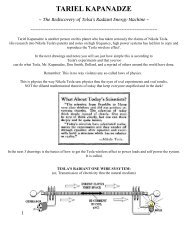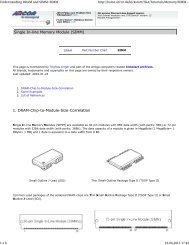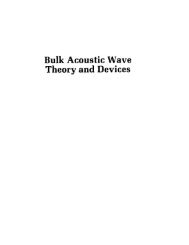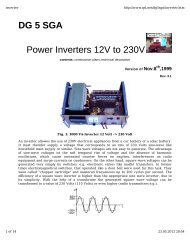New Energy Technologies Magazine nr 3 2005.pdf - Index of
New Energy Technologies Magazine nr 3 2005.pdf - Index of
New Energy Technologies Magazine nr 3 2005.pdf - Index of
You also want an ePaper? Increase the reach of your titles
YUMPU automatically turns print PDFs into web optimized ePapers that Google loves.
valve and opens the pressure one while the<br />
pressure decrease influences the reverse<br />
sequence. All meaning <strong>of</strong> the device's operation<br />
is that it raises water volume qH at height H<br />
using water volume's energy q.<br />
However, the "hydraulic ram", as the water lifting<br />
device, has a very important disadvantage.<br />
In order to obtain the water increase, it is<br />
necessary to discharge a certain amount <strong>of</strong><br />
water qk=q-qH. Water flowing out <strong>of</strong> the<br />
impact valve must quickly vacate a place for a<br />
new portion <strong>of</strong> water, which will flow out during<br />
the next cycle. If water at the outlet <strong>of</strong> the drain<br />
hole will gather somehow, an insuperable<br />
resistance for water flow out will form and, as a<br />
result, the water acceleration in the force pipe<br />
will be broken and then stop.<br />
As a result, the given device being in the<br />
submerged state, i.e. submerged in water,<br />
cannot operate. This prevents its use in the flat<br />
country with open reservoirs and on rivers<br />
without slopes or without dams.<br />
Besides that, the "hydraulic ram" attracted<br />
attention <strong>of</strong> scientific theorists and experts by<br />
its originality and operation simplicity. During<br />
the XIX century, many theoretical researches<br />
<strong>of</strong> the "hydraulic ram" were carried out but, until<br />
1900, they all rested on the fact that the theory<br />
<strong>of</strong> a "hydraulic blow" in pipes had been unknown<br />
and, therefore, gave no correct results. As early<br />
as in 1804, Eitelvein from Germany carried out<br />
more than 1,000 experiments and published a<br />
number <strong>of</strong> empirical conclusions and formulas.<br />
Most <strong>of</strong> them, as it was found out already at<br />
that time, were not suitable for designing.<br />
The fact <strong>of</strong> existence <strong>of</strong> the "hydraulic blow" effect<br />
was known as early as in the XVIII century, but a<br />
right theory was developed for the first time by a<br />
Russian scientist, N.E. Zhukovsky. Pr<strong>of</strong>essor<br />
Zhukovsky checked and confirmed his theoretical<br />
conclusions by special experiments in 1897-1898.<br />
In 1898, his theory was first published in<br />
"Bulletins <strong>of</strong> Polytechnic Society".<br />
In 1901, an Italian engineer Alievi published<br />
almost the same theory <strong>of</strong> the "hydraulic blow"<br />
but in relation to pipelines <strong>of</strong> different powerplants.<br />
However, the experiments carried out by<br />
Zhukovsky and, later, by other researchers from<br />
other countries completely proved the accuracy<br />
<strong>of</strong> basic concepts <strong>of</strong> Zhukovsky’s theory. But this<br />
theory, even after its publication, did not obtain<br />
proper acknowledgement. Researchers and<br />
enthusiasts <strong>of</strong> the "hydraulic ram", as usual,<br />
from year to year, carried out experiments and<br />
found different non-generalized formulas for<br />
their purposes.<br />
The "hydraulic ram" was developed under the<br />
name <strong>of</strong> «ram-pump» in melioration and in<br />
private life as a device for free water lifting in<br />
America, Australia and other western countries.<br />
Today there are several dozen small companies<br />
specializing in the production and sale <strong>of</strong> the<br />
«ram-pump» in these countries. Searching<br />
Internet for words "hydraulic ram" or «rampump»<br />
by different search engines, it is possible<br />
to find not only these companies but also some<br />
publications on this subject. Many companies<br />
use only their own formulas installing their<br />
«ram-pumps».<br />
In Russia, right after the publication <strong>of</strong> the<br />
"hydraulic blow" theory by Zhukovsky, the work<br />
on the creation and development <strong>of</strong> the "hydraulic<br />
ram" theory was successfully continued by his<br />
disciples and following: B. Bubekin, B. Bahmetiev,<br />
S. Chistopolsky. For example, Pr<strong>of</strong>essor<br />
Zhukovsky created the right scheme <strong>of</strong> the<br />
"ram's" operation during water delivery relying<br />
on the results <strong>of</strong> special experiments carried out<br />
by B. Bubekin from 1903 to 1907 and described it<br />
in a report on "The new hydraulic ram theory" in<br />
Mathematical Society on the 18th <strong>of</strong> September<br />
1907. Later on, Pr<strong>of</strong>essor B. Bahmetiev gave the<br />
right interpretation <strong>of</strong> the water acceleration<br />
period in researches by Navler and Harza in his<br />
work "Introduction to the research <strong>of</strong> the<br />
unbalanced liquid flow" on the basis <strong>of</strong> the same<br />
theory <strong>of</strong> Zhukovsky. However, it was Pr<strong>of</strong>essor<br />
S. Chistopolsky who finally combined theory and<br />
practice in his work "A hydraulic ram" in 1930.<br />
He created the first and, to present day, the only<br />
known and reliable method <strong>of</strong> the theoretical<br />
calculation. This method was, and is, completely<br />
confirmed by the results <strong>of</strong> numerous tests.<br />
Unfortunately, the "hydraulic ram", as the<br />
device for free water lifting, was undeservedly<br />
forgotten as petroleum production has been<br />
50 <strong>New</strong> <strong>Energy</strong> <strong>Technologies</strong> #3(22) 2005



